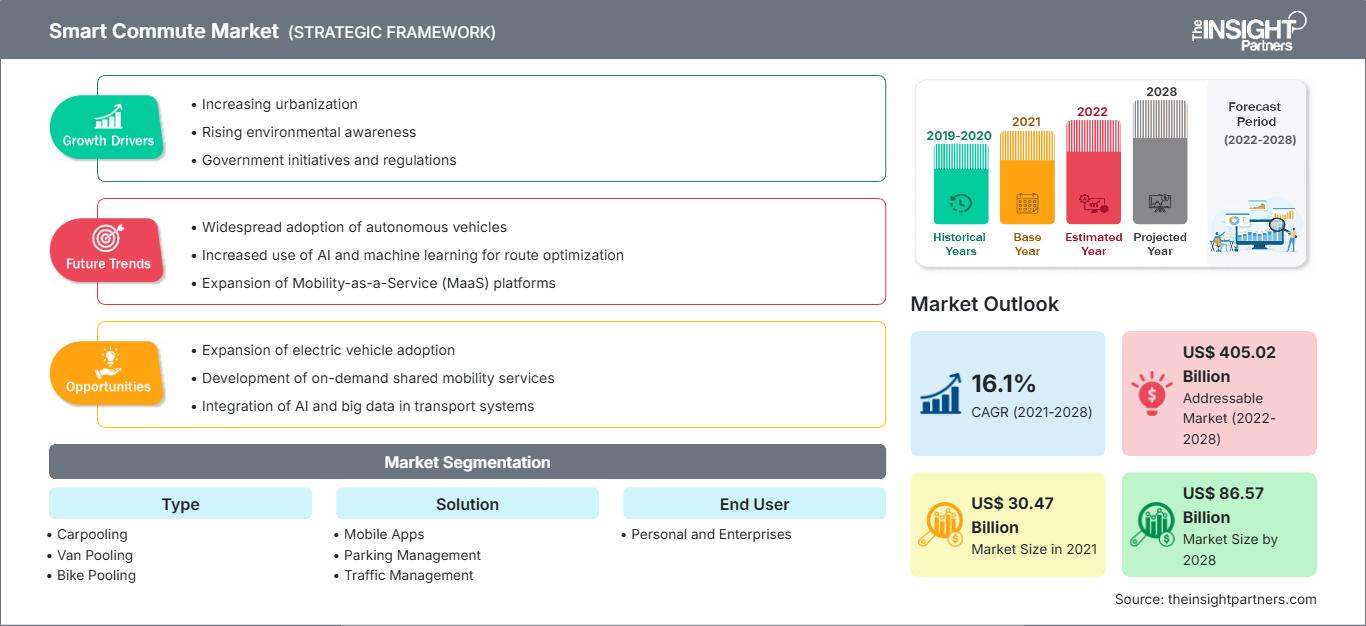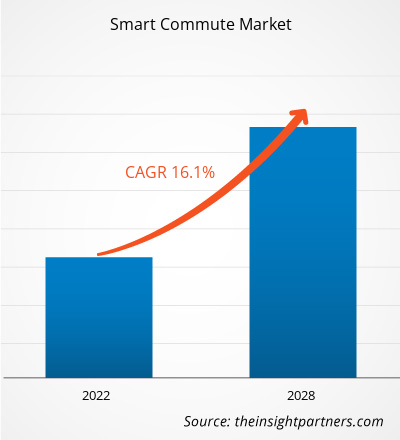预计智能通勤市场规模将从2021年的304.6949亿美元增长到2028年的865.6873亿美元;预计2021年至2028年的复合年增长率为16.1%。
智能通勤的定义是指定期通过拼车、面包车、自行车、自行车或乘坐地铁等方式出行。公共交通公司、政府和其他利益相关者已经制定了一套完整的战略,将智能出行纳入考量,并与公众分享,以在大都市地区构建更强大的交通体系。智能通勤通过减少交通拥堵和温室气体排放,对环境产生了积极影响。
通过智能通勤服务,人们可以获得拼车、共享单车、面包车和其他环保的通勤选择。它为办公室工作人员提供了一种交通选择,使他们能够选择更有效的通勤路线,从而减少交通拥堵和交通支出。推动智能通勤市场增长的因素之一是城市居民数量的增长,从而导致世代率的上升。共享交通服务已获得普遍接受,并受到政府和环保机构的鼓励,因为它有助于减少排放。它减少了私家车的数量,预计这将在未来几年推动智能通勤市场的增长。
在北美,办公室通勤者越来越倾向于拼车服务,这刺激了对智能通勤的需求,因为拼车服务可以缓解交通拥堵并防止环境破坏。此外,旅游业的兴起、技术进步和有利的政府政策也是推动北美智能通勤市场增长的其他因素。在欧洲,“出行即服务”趋势的兴起以及共享出行服务用户群的扩大,预计将为市场参与者创造丰厚的利润。
在欧洲,由于人们对全球变暖、道路拥堵以及对外国能源依赖的担忧日益加剧,智能通勤车越来越受欢迎。自2012年起,对单人驾驶的汽车征收通行费的做法已大幅提升了欧洲消费者对智能通勤车的使用率。
自定义此报告以满足您的要求
您将免费获得任何报告的定制,包括本报告的部分内容,或国家级分析、Excel 数据包,以及为初创企业和大学提供超值优惠和折扣
智能通勤市场: 战略洞察

-
获取本报告的主要市场趋势。这个免费样本将包括数据分析,从市场趋势到估计和预测。
新冠疫情对智能通勤市场的影响
新冠疫情对交通运输行业造成了重大影响。受新冠疫情影响,2020 年全球拼车和厢式货车服务需求下降。与 2019 年相比,2020 年全球智能通勤市场的收入大幅下降,部分原因是封锁以及即使在封锁解除后,客户仍不愿使用拼车服务。拼车公司始终努力在安全和卫生方面维护驾驶员和乘客的信心。
市场洞察 – 智能通勤市场
出行即服务趋势日益增长
无力购买汽车的人可以通过出行服务体验无缝出行。根据美国交通统计局的数据,假设每年行驶15,000公里,拥有和运营一辆汽车的平均成本约为8,858美元。出行即服务通过最大限度地利用拼车和网约车等交通服务,为用户降低了这些成本。它还能减少城市的交通拥堵和汽车排放总量。因此,数字化的拼车和网约车服务可以有效地管理交通需求,并为私人汽车所有权提供一种便捷环保的替代方案。此外,据统计,目前全球55%的人口居住在城市,预计到2050年,约有68%的人口将居住在城市。快速的城市化进程已经导致交通拥堵。出行即服务 (MaaS) 概念或许是减少交通拥堵的更好选择,因为它可以更好地利用现有的公共和私人交通基础设施。智慧城市迫切需要更快捷、更经济、更便捷的有效交通解决方案,预计到 2028 年,这一需求将推动 MaaS 市场的增长。因此,出行即服务 (MaaS) 的增长趋势预计将推动全球智能通勤市场的增长。
基于类型的智能通勤市场洞察
根据类型,智能通勤市场细分为拼车、面包车拼车、自行车拼车、地铁和其他。预计拼车市场将在全球智能通勤市场中占据重要份额,并有望以最高的复合年增长率增长。智能通勤被定义为通过拼车、拼车、骑自行车、自行车或乘坐地铁定期从一个地点到另一个地点的出行。
基于解决方案的智能通勤市场洞察
根据解决方案,智能通勤市场细分为移动应用、停车管理、交通管理等。预计移动应用领域将在全球智能通勤市场中占据重要份额,并有望以最高的复合年增长率增长。在汽车出行方式中,移动应用的使用日益增多,以减少出行时间、成本和车辆排放。
基于最终用户的智能通勤市场洞察
根据最终用户,智能通勤市场分为个人和企业。预计企业领域将在全球智能通勤市场中占据重要份额,并有望以更高的复合年增长率增长。
智能通勤市场
The Insight Partners 的分析师已详尽阐述了预测期内影响智能通勤市场的区域趋势和因素。本节还讨论了北美、欧洲、亚太地区、中东和非洲以及南美和中美洲的智能通勤市场细分和地域分布。
智能通勤市场报告范围
| 报告属性 | 细节 |
|---|---|
| 市场规模 2021 | US$ 30.47 Billion |
| 市场规模 2028 | US$ 86.57 Billion |
| 全球复合年增长率 (2021 - 2028) | 16.1% |
| 历史数据 | 2019-2020 |
| 预测期 | 2022-2028 |
| 涵盖的领域 |
By 类型
|
| 覆盖地区和国家 |
北美
|
| 市场领导者和主要公司简介 |
|
智能通勤市场参与者密度:了解其对商业动态的影响
智能通勤市场正在快速增长,这得益于终端用户需求的不断增长,而这些需求的驱动因素包括消费者偏好的不断变化、技术进步以及对产品优势的认知度不断提高。随着需求的增长,企业正在扩展其产品线,不断创新以满足消费者需求,并抓住新兴趋势,从而进一步推动市场增长。

- 获取 智能通勤市场 主要参与者概述
智能通勤市场的参与者主要专注于开发先进高效的产品。
- 2022 年 1 月,多式联运出行公司 Tummoc 计划到 2022 年将业务扩展到其他十个城市,包括德里和孟买。
- 2021 年 4 月,一家城市出行公司首次构建了一个整合路线和价格的应用平台,将公交车、地铁、Uber、Yulu 和其他最后一英里的选择结合在一起。
公司简介
:- BlaBlaCar
- CommuteSmart
- Enterprise Holdings Inc
- ePoolers Technologies Pvt. Ltd
- Golden Concord Holdings Limited
- 奥克兰智能通勤
- Quick Ride
- Transhelp Technologies Pvt Ltd
- Uber Technologies Inc.
- 智能通勤
- 历史分析(2 年)、基准年、预测(7 年)及复合年增长率
- PEST和SWOT分析
- 市场规模、价值/数量 - 全球、区域、国家
- 行业和竞争格局
- Excel 数据集
近期报告
客户评价
购买理由
- 明智的决策
- 了解市场动态
- 竞争分析
- 客户洞察
- 市场预测
- 风险规避
- 战略规划
- 投资论证
- 识别新兴市场
- 优化营销策略
- 提升运营效率
- 顺应监管趋势






















 获取免费样品 - 智能通勤市场
获取免费样品 - 智能通勤市场